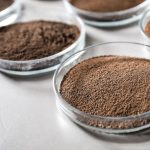SGS Seed and Crop News: June 2019
Seed and Crop eNewsletter: June 2019
In this edition of SGS BioVision News, we will discuss:
- SGS BioVision in the news for ISTA accreditation
- Benefit of water testing in crop production and greenhouse fertigation
- Using tissue analysis to unlock hidden nutrient deficiencies
- Diagnosing Root Rots in Pulses: Aphanomyces and Fusarium
- Pre-sidedress Nitrate Testing to optimize N rates in corn production
- Blackleg race testing in canola ready to launch
Ask an Analyst: How do I properly sample and ship tissue samples?
SGS BIOVISION IN THE NEWS FOR NEW ISTA ACCREDITATION
SGS BioVision’s laboratory in Sherwood Park has received International Seed Testing Association (ISTA) accreditation to further support Canadian seed companies with meeting global export requirements. Read the press release or listen to the podcast that was featured on germination.ca Our ISTA accreditation covers sampling and testing for the generation of Orange International Seed Lot Certificates and Blue International Seed Sample Certificates. Testing includes purity testing, determination of other seeds, germination, viability and moisture content. For further information contact BioVision.SherwoodPark@sgs.com.
WATER ANALYSIS PACKAGES
SGS provides water analysis for many agricultural operations.
- For greenhouses, nurseries, and garden centres, seasonal testing of raw water enables the balancing of nutrients, pH, and EC.
- Crop production can benefit from a water test to ensure that pH and bicarbonate levels are adequately adjusted to optimize mixing of sprayed products and soluble nutrients.
- For producers of livestock, monitoring mineral levels of drinking water and balancing where necessary can contribute to overall animal health.
- Vegetable production requires microbiological testing of irrigation water and wash water for food safety purposes.
- The SGS Irrigation Water Report is utilized by producers that irrigate field crops. It measures plant nutrients, and also converts to pounds of nutrient per acre-inch of water applied.
250 mls is an adequate sample size for most analysis.
USING TISSUE ANALYSIS TO UNLOCK HIDDEN NUTRIENT DEFICIENCIES
A valuable but underutilized tool in the nutrient management toolbox is plant tissue analysis. It is relatively common to test plant tissue to diagnose or confirm a deficiency when crops appear symptomatic, but much less frequently are samples submitted to monitor nutrient levels. It is possible for crops to appear healthy and robust, despite low nutrient concentrations. Known as ‘hidden hunger’, a tissue analysis can accurately measure nutrient levels, and reveal if any are below minimum thresholds so that supplemental applications can be performed before yield is reduced. If variability exists within a field, sampling a ‘good’ and a ‘poor’ area separately can often reveal the nutrients that are contributing to the differences.
DIAGNOSING ROOT ROTS IN PULSES: APHANOMYCES EUTEICHES AND FUSARIUM
Aphanomyces euteiches is a persistent root rot pathogen, infecting peas, lentils, dry beans, as well as alfalfa, during the entire growing season. Take notice, as this soil borne fungi belongs to the oomycete family, in which the spores survive in a resting state for up to 10 years, plus the spores are water mobile. Root rot in peas is typically due to infection of Aphanomyces euteiches and/or Fusarium (most prevalent F. avenaceum and F. solani), so DNA lab confirmation is critical. We offer two service options for our clients:
- Standard Aphanomyces euteiches DNA detection test for soil and tissue.
- Comprehensive Root Rot molecular analysis for presence of Aphanomyces and Fusarium in soil and tissue.
PRE-SIDEDRESS NITRATE TESTING (PSNT) TO MAXIMIZE ONTARIO CORN PRODUCTION
Splitting the application of nitrogen on corn can help minimize losses of N due to weather factors. Extracting a 12-inch depth soil sample from a standing crop, at approximately the 3 to 5 leaf stage, can give an accurate measurement of available nitrate-N, and allow for adjustment of sidedress rates of additional nitrogen. Sampling areas that historically perform differently, or that have differing soil types and organic matter (often based on slope position) may also offer management opportunities to optimize nitrogen use. PSNT samples should be kept cool and shipped to the laboratory as soon as possible.
BLACKLEG RACE TESTING IN CANOLA READY TO LAUNCH
Blackleg is a disease of canola caused by the fungal pathogen Leptosphaeria maculans, contributing to stem cankers, girdling, pre-mature ripening and lodging. Choosing canola cultivars with different resistance genes is a NEW tool to manage blackleg disease, as introduced by the Canola Council of Canada. Understanding which races are present in your fields can assist with choosing the appropriate resistance gene in your next canola rotation. To determine the races in your fields we have commercialized the KASP™ system (Kompetitive Allele Specific PCR), an endpoint genotyping technology. Stay tuned for our next newsletter, as we will outline sampling procedures, as stem tissue sampled post-harvest is the best time to sample.
ASK AN ANALYST: HOW DO I PROPERLY COLLECT AND SHIP TISSUE SAMPLES FOR NUTRIENT TESTING?
Nutrient analysis of plant tissue samples requires a sample that is representative to the whole area being tested. Each sample should consist of a minimum of 200 grams of fresh material, which equates to half a paper lunch bag for most crops. Problem plants/areas should be sampled and submitted separately. Take due care to not contaminate the sample with soil, as this will cause invalid results, especially for micro nutrients. Tissue samples should always be packaged in paper, so that they air dry naturally en route to the laboratory. Do not package in plastic, as the transpiration from the tissue will result in tissue breakdown. All tissue MUST be couriered to the laboratory. For information on the plant part to sample and the stage of growth, contact ca.agri.guelph.lab@sgs.com.





